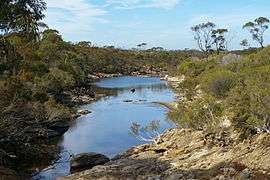Fitzgerald River National Park
| Fitzgerald River National Park Western Australia | |
|---|---|
|
IUCN category II (national park) | |
 Gairdner River in the National Park | |
 Fitzgerald River National Park | |
| Coordinates | 33°56′51″S 119°36′55″E / 33.94750°S 119.61528°ECoordinates: 33°56′51″S 119°36′55″E / 33.94750°S 119.61528°E |
| Established | 1973 |
| Area | 2,972.11 km2 (1,147.5 sq mi)[1] |
| Visitation | 40,000 (in 2008) |
| Managing authorities | Department of Environment and Conservation |
| Website | Fitzgerald River National Park |
| See also |
List of protected areas of Western Australia |

Fitzgerald River National Park is a national park in Western Australia (Australia), 419 kilometres (260 mi) southeast of Perth, in the Shire of Ravensthorpe and the Shire of Jerramungup.
Description
The park includes the Barren Mountains and Eyre Range and the Fitzgerald River as well as incorporating the Fitzgerald Biosphere. There are 62 plant species which are unique to the 329,882 hectares (815,160 acres) park and a further 48 are rarely found elsewhere.
Recording almost 40,000 visitors in 2008, the park received $20 million in funding from the federal government's economic stimulus plan with the state government contributing an additional $20 million. The investment is to be used to redevelop and seal 80 km (50 mi) of roads within the park, construct a walk trail from Bremer Bay to Hopetoun and upgrade existing recreational facilities.[2]
Point Ann is one of the two places (the other is Head of the Bight) along Australia's coast where southern right whales come to calve during their winter migration.
Within the National Park is the Quaalup Homestead Wilderness Retreat (now run as a hotel) that was built in 1858 by the Wellstead Family. In 1890, the Hassell family took over the pastoral lease and the homestead.
The park can be accessed from the western side via Bremer Bay, or from the eastern side via Hopetoun. The central area of the park is only accessible with a four-wheel drive vehicle or on foot.
Many of the peaks in the park are off limits to climbers to prevent the spread of dieback or root rot from Phytophthora cinnamomi.
Flora and fauna
The park forms the basis of the internationally recognised Biosphere Reserve recognised by the UNESCO Man and Biosphere Program. The site contains over 1800 species of plant with 250 of these being rare and 62 being known to be found only within the confines of the park.[3] Some species of interest include the royal hakea, qualup bell, scarlet banksia, showy banksia, bell-fruit mallee, pea flowers, feather flowers, many species of eucalypts and bottlebrushes (Callistemon and Beaufortia).[4]
Three populations of the crowned mallee all exist within the park and have a total number of 140 trees.[5] An endangered species, Boronia clavata, has five populations totalling only 100 individuals all of which are located in the area.[6] Another two endangered species, the barrens wedding bush and the fan-leaf grevillea, are also found within the park although in the case of the barrens wedding bush, not exclusively.[7][8]
The park is also home to 22 species of mammal, 200 bird species, 41 species of reptile and 12 species of frog. It is recognised as an Important Bird Area;[9] some of the rarer species are the western bristlebird, western ground parrot and the western whipbird.[10] The endangered malleefowl is also known to inhabit the park with seven known and recorded sightings having been made 1998.[11] Some of the mammals found are the very rare dibbler and the heath rat, both of which were thought to be extinct at one time or another. The tammar wallaby and woylie, both of which are threatened species, are known to inhabit the mallee and heath areas of the park.[12] Other species such as the quenda, chuditch and the red-tailed phascogale also inhabit the area.[13]
Migratory birds find refuge in the wetland and coastal regions and species that temporarily inhabit the area include the white-bellied sea eagle, Pacific swift and the Caspian tern.
- Barren Mountain Range
- Looking south towards the coast.
- Quaalup Homestead
See also
References
- ↑ "Department of Environment and Conservation 2009–2010 Annual Report". Department of Environment and Conservation. 2010: 48. ISSN 1835-114X. Archived from the original on 11 January 2011.
- ↑ "Media Release – $20 Million Investment in Fitzgerald River National Park". 2009. Retrieved 21 May 2010.
- ↑ "Department of Environment Park Fnder – Fitzgerald River National Park". 2008. Retrieved 21 May 2010.
- ↑ "Matters of Public Interest – Fitzgerald River National Park & Whaling". 2009. Retrieved 21 May 2010.
- ↑ "Approved conservation advice for Eucalyptus coronata" (PDF). 2009. Retrieved 21 May 2010.
- ↑ "Biodiversity – Species profile – Bremer Boronia". 2009. Retrieved 1 May 2010.
- ↑ "Approved conservation advice for Ricinocarpos trichophorus" (PDF). 2008. Retrieved 21 May 2010.
- ↑ "Approved conservation advice for Grevillea Infundibularis" (PDF). 2008. Retrieved 21 May 2010.
- ↑ "IBA: Fitzgerald River". Birdata. Birds Australia. Archived from the original on 6 July 2011. Retrieved 20 June 2011.
- ↑ "Department of Environment Park Fnder – Fitzgerald River National Park". 2008. Retrieved 26 May 2010.
- ↑ "Biodiversity – Species profile – Leipoa ocellata". 2010. Retrieved 26 May 2010.
- ↑ "Ravensthorpe Caravan Park – Fitzgerald River National Park". 2008. Retrieved 26 May 2010.
- ↑ "Southern Western Australia – An Eco Paradise". 2009. Retrieved 26 May 2010.
External links
| Wikimedia Commons has media related to Fitzgerald River National Park. |